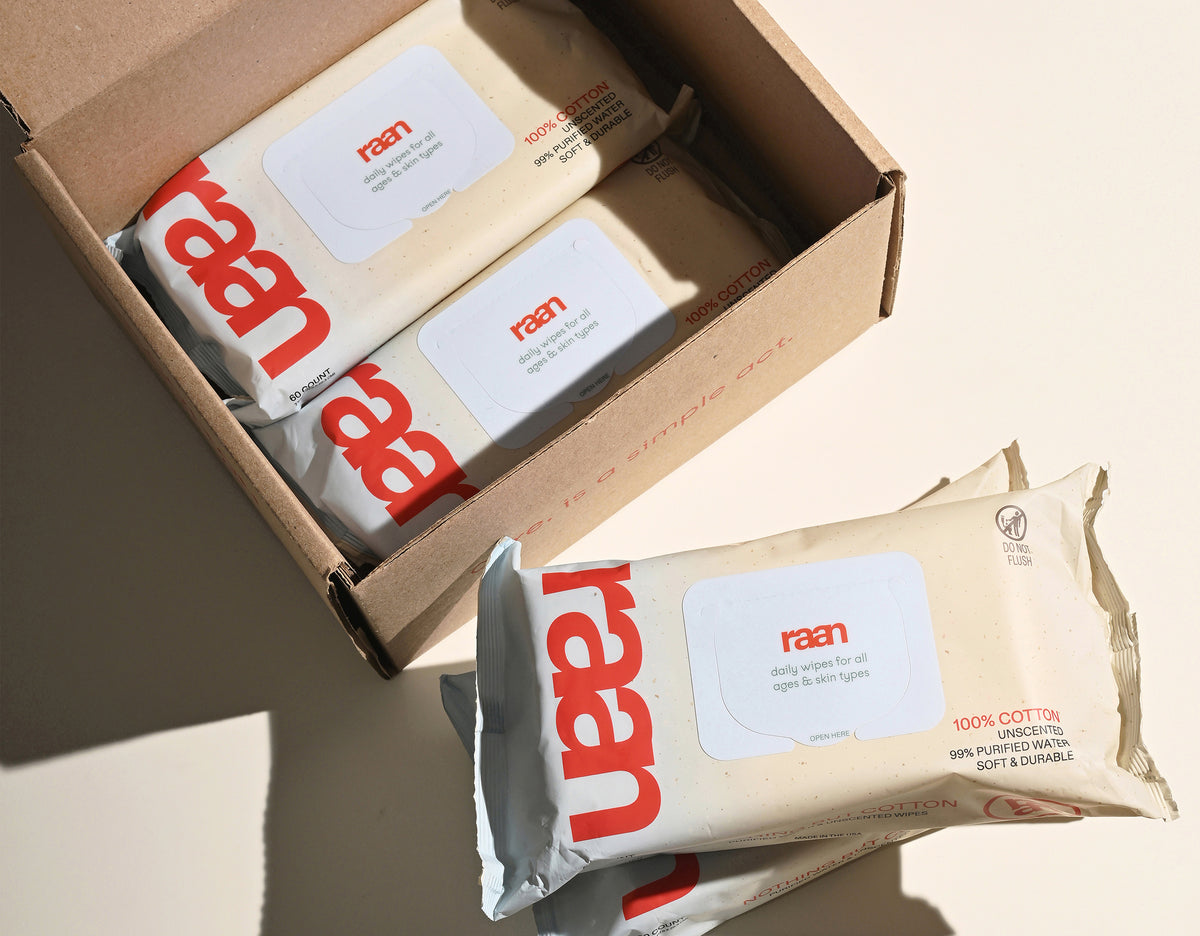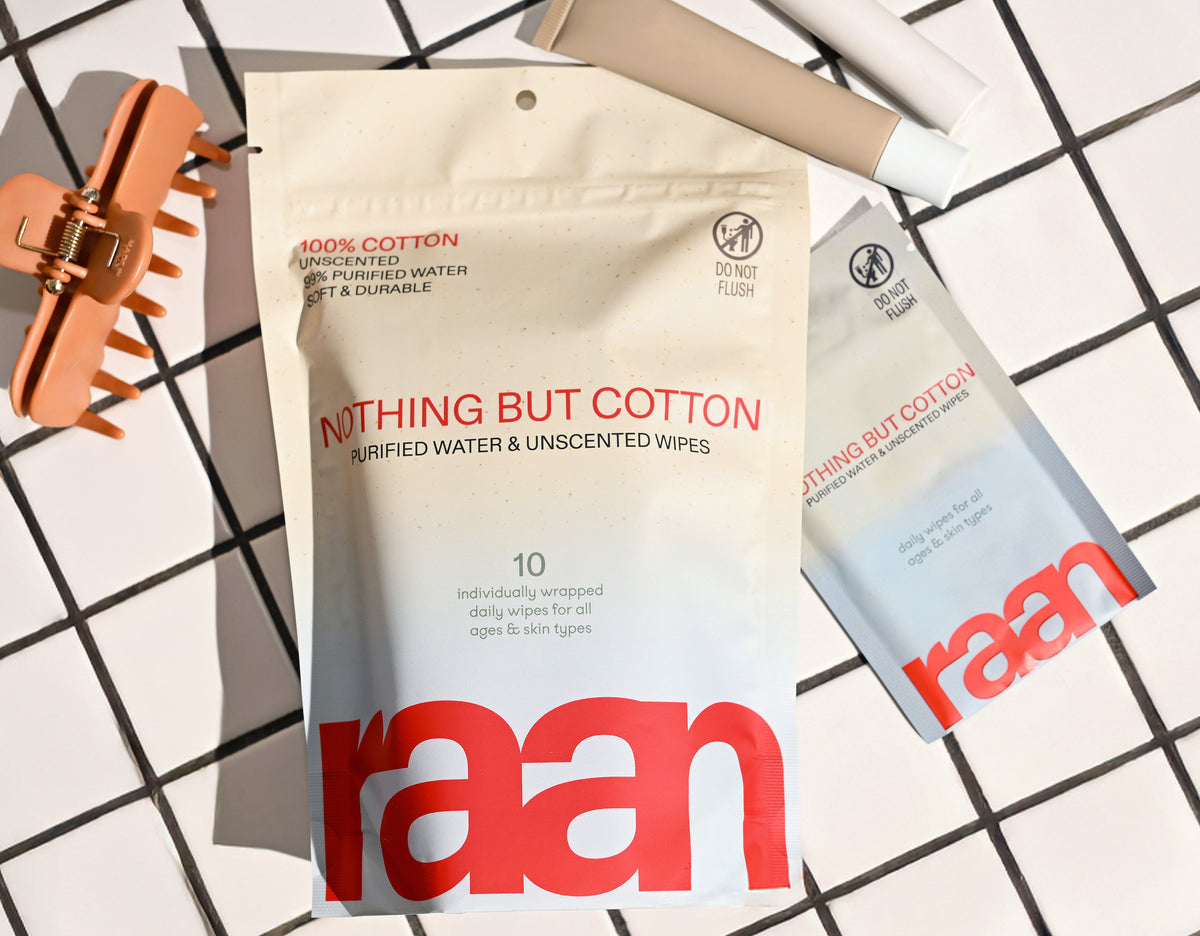Key Takeaways
- Choosing the best cotton pad for period care can be confusing due to unclear product claims and certifications.
- Many period products use vague terms like "natural" without providing detailed information.
- Packaging often fails to disclose the materials that come into contact with your skin.
- Understanding material safety is essential for selecting the right cotton pad for period care.
Table of Contents
- Understanding Cotton Pads for Period Care
- Why Material Matters: Health Considerations for Sensitive Skin
- Environmental Impact: Beyond the "Eco-Friendly" Label
- Key Selection Criteria: Matching Pads to Your Needs
- Top Cotton Pad Recommendations
- How to Choose the Right Cotton Pad for You
- Using Cotton Pads Effectively
- Understanding What's Inside: Ingredient Transparency
- Caring for Your Body During Your Period
Finding the best cotton pad for period care shouldn't require a chemistry degree, but navigating today's market often feels that way. Between vague "natural" claims, confusing certifications, and packaging that reveals little about what actually touches your skin, choosing period products has become unnecessarily complex.
The shift toward material transparency in menstrual care isn't just a trend, it's a response to decades of products loaded with synthetic materials, chemical fragrances, and processing methods that prioritize shelf appeal over skin safety. Cotton-based period pads offer a clearer alternative: breathable, gentle materials that work with your body rather than against it.
This guide cuts through the marketing noise to examine what actually matters: material composition, health considerations, environmental impact, and practical selection criteria. We'll explore how different cotton processing methods affect both comfort and safety, helping you make informed decisions based on facts, not aspirational claims. For those seeking a convenient solution for on-the-go freshness, individually wrapped cotton wipes can be a helpful addition to your period care routine.
Understanding Cotton Pads for Period Care
What Makes a Cotton Pad Different
Cotton-based menstrual pads use natural cotton fibers as the primary skin-contact material, creating a soft, breathable barrier between your body and the absorbent core. Unlike synthetic alternatives, cotton maintains its natural texture and breathability even when processed, offering a distinctly different feel, less plastic-like, more fabric-soft.
The key distinction lies in construction: 100% cotton pads use cotton throughout all layers, while "cotton-topped" products only feature cotton on the surface, with synthetic materials underneath. Cotton-blend products mix natural and synthetic fibers, often reducing the breathability and gentleness that make pure cotton appealing.
The Material Science Behind Cotton Absorbency
Natural cotton fibers contain microscopic spaces that wick moisture away from skin while allowing air circulation. This dual action, absorption plus breathability, helps maintain a drier surface compared to non-porous synthetic materials that can trap moisture against sensitive tissue.
Processing methods significantly impact these natural properties. Unbleached cotton retains more of its original fiber structure, while chlorine bleaching can leave chemical residues and weaken the material's natural qualities. The difference is often visible: unbleached cotton appears cream-colored rather than bright white, indicating minimal chemical processing. For a deeper look at the benefits of unbleached cotton, you may find this article on unbleached cotton helpful.
- Unbleached cotton maintains natural fiber integrity
- 100% cotton construction throughout all layers
- Soft texture without synthetic coating feel
- Natural breathability for extended wear comfort
Why Material Matters: Health Considerations for Sensitive Skin

Direct Skin Contact and Vulvar Health
Vulvar tissue is among the most sensitive areas of the body, with thinner skin and mucous membranes that absorb substances more readily than other areas. The materials in direct contact during menstruation can either support or disrupt the natural pH balance and healthy flora that protect against irritation and infection.
Synthetic materials, chemical fragrances, and processing residues can trigger contact dermatitis, itching, or allergic reactions in sensitive individuals. The prolonged contact during menstruation, often 12+ hours daily for several days, amplifies exposure to any potentially irritating substances present in pad materials.
What to Avoid in Period Pads
Several common pad additives pose unnecessary risks for sensitive skin and overall health:
- Synthetic fragrances: Can disrupt natural pH and cause contact dermatitis
- Chlorine bleaching residues: May leave dioxin traces that accumulate over time
- Plastic-based top sheets: Reduce breathability and can trap moisture
- Vague "hypoallergenic" claims: Often meaningless without ingredient transparency
- Superabsorbent polymers: Synthetic gels that may contain chemical additives
Who Benefits Most from Cotton Pads
People with reactive skin conditions like eczema or psoriasis often find cotton pads gentler during flare-ups, when skin barriers are already compromised. Postpartum recovery presents another scenario where cotton's gentleness becomes crucial, healing tissue requires minimal chemical exposure and maximum breathability.
New menstruators establishing their routines benefit from cotton's predictable, gentle nature while learning what works for their bodies. Anyone seeking fewer unknowns in intimate-care products finds value in cotton's simple, transparent composition compared to complex synthetic formulations with undisclosed ingredients.
Environmental Impact: Beyond the "Eco-Friendly" Label
The Full Lifecycle of a Menstrual Pad
A typical disposable pad containing plastic components can persist in landfills for 500-800 years, with synthetic polymers breaking down into microplastics rather than biodegrading completely. Cotton-based pads, particularly those made from unbleached cotton, decompose within 5-6 months under proper composting conditions.
Packaging compounds the environmental footprint significantly. Traditional pad packaging often includes hard plastic dispensers, individual plastic wrappers, and non-recyclable pouches. Some cotton pad brands reduce this impact by up to 70% through minimal packaging designs that skip plastic dispensers and use recyclable materials. For those looking for a more sustainable approach to period care, the mess-ready pack offers a convenient and eco-conscious solution.
What "Biodegradable" Actually Means
True biodegradability requires specific conditions and timeframes that vary dramatically between industrial composting facilities and home compost bins. Cotton naturally biodegrades, but adhesives, plastic backings, and synthetic cores in hybrid products prevent complete decomposition.
Certification standards matter: ASTM D6400 certification indicates industrial compostability within 180 days, while home compostable materials break down within 12-24 months under optimal conditions. Understanding these distinctions helps you make disposal decisions that align with your environmental values.
The reality is that even the most biodegradable cotton pad contains some non-compostable components, adhesives, packaging, and plastic barriers. Choose products that minimize these elements and dispose of them thoughtfully, knowing that material transparency leads to better end-of-life outcomes. For more on the environmental impact of cotton wipes, you might find this article on biodegradable cotton wipes for cleaning insightful.
Key Selection Criteria: Matching Pads to Your Needs
Absorbency and Flow Levels
Your flow changes throughout your cycle, and the best cotton pad for period care adapts to these variations. Light days require thin, breathable protection that moves with your body, while heavy flow demands multi-layer cores that lock in moisture without bulk.
Test absorbency needs over 1-2 cycles before committing to one product. Overnight pads typically feature extended length and higher-capacity cores, but daytime movement requires flexibility over maximum absorption. Match your most challenging day, not your lightest, when selecting primary absorbency levels.
Material Transparency and Ingredient Lists
True material transparency means listing every component that touches your skin. Look for "100% cotton" in the top sheet description, not buried in marketing copy. "Cotton-feel" or "cotton-topped" indicates synthetic blends that may trigger sensitivity in reactive skin.
Label Reading Checklist:
- Unbleached cotton appears cream or natural-colored, never bright white
- Ingredient lists should specify preservatives by name, not "natural fragrance"
- Avoid vague claims like "dermatologist-tested" without certification details
- EWG Verified products undergo ingredient-level screening for safety concerns
Certifications That Matter
EWG Verified certification screens over 2,000 chemicals of concern, providing third-party validation beyond marketing claims. This standard evaluates every ingredient for reproductive toxicity, developmental harm, and skin sensitization, criteria that matter for intimate-contact products.
GOTS certification ensures organic cotton meets environmental and social standards throughout production, while cruelty-free verification confirms no animal testing occurred during development. These certifications cost manufacturers time and money, indicating genuine commitment to safety standards rather than superficial marketing.
Comfort and Fit Features
Wings provide secure placement during movement, but their adhesive quality determines comfort over extended wear. Flexible materials bend with your body during exercise, sitting, and sleeping without creating pressure points or shifting position.
Thin pads offer discretion but may require more frequent changes during heavy flow. Thick pads provide confidence but can feel bulky under fitted clothing. The best cotton pads for periods balance absorbency with wearability, using efficient core construction rather than added bulk.
Top Cotton Pad Recommendations

Raan Cotton Wipes - Gentle Care Companion
Best for: On-the-go cleansing and sensitive skin support during menstrual care
While Raan specializes in personal care wipes rather than menstrual pads, our unbleached 100% cotton wipes complement period care perfectly. The five-ingredient formula, 99% purified water, organic aloe, and food-grade preservatives, provides gentle cleansing between pad changes without disrupting natural pH balance.
EWG Verified ingredients and plastic-free construction make these wipes ideal for sensitive vulvar tissue. The unbleached cotton feels naturally soft against skin, while the minimalist pouch design uses 70% less plastic than conventional wipe packaging. If you're looking to try a curated set of essentials, the starter set is a great way to experience gentle cotton care for your period routine.
Organic Cotton Disposable Pads - Natural Absorption
Best for: Chemical-sensitive users seeking certified organic materials
GOTS-certified organic cotton pads eliminate pesticide residues and synthetic processing chemicals. The unbleached cotton top sheet maintains breathability while organic cotton cores provide reliable absorption without superabsorbent polymers.
These pads typically cost 20-30% more than conventional options but offer peace of mind for users with multiple chemical sensitivities or those recovering from infections where gentle materials support healing.
Unbleached Cotton Hybrid Pads - Performance Balance
Best for: Heavy flow days requiring maximum absorbency with natural top sheets
Hybrid construction combines unbleached cotton top sheets with high-capacity cores for extended protection. These pads maintain skin-contact benefits of natural cotton while incorporating absorbent technology for active lifestyles.
The trade-off involves non-biodegradable core materials, but the natural top sheet reduces direct synthetic contact during wear. This option works well for users transitioning from conventional pads who need familiar absorbency levels.
| Feature | Raan Cotton Wipes | Organic Cotton Pads | Hybrid Cotton Pads |
|---|---|---|---|
| Top Sheet Material | 100% unbleached cotton | GOTS organic cotton | Unbleached cotton blend |
| Ingredient Transparency | 5 listed ingredients | Full ingredient list | Partial ingredient list |
| Certifications | EWG Verified, Cruelty Free | GOTS, Cruelty Free | Varies by brand |
| Plastic Content | Plastic-free wipe, 70% less plastic packaging | Minimal (backing only) | Plastic in core/backing |
| Best Use | Gentle cleansing, on-the-go | Daily period protection | Heavy flow, extended wear |
How to Choose the Right Cotton Pad for You
Assess Your Priorities
Start with your non-negotiables: material safety, absorbency level, and skin sensitivity requirements. If you react to fragrances or synthetic materials, unbleached cotton with minimal ingredients becomes essential rather than optional.
Secondary preferences, packaging sustainability, certifications, or subscription convenience, matter only after your core needs are met. This hierarchy prevents decision paralysis when comparing products that check different boxes but miss your primary requirements.
Match Product Features to Your Lifestyle
New moms need postpartum-level absorbency with materials gentle enough for healing tissue. Look for extended-length pads with organic cotton top sheets and avoid anything with synthetic fragrances that could irritate sensitive areas.
Sensitive skin requires unbleached cotton, fragrance-free formulations, and third-party safety certifications like EWG Verified. These users benefit from brands that list every ingredient rather than hiding behind "natural" or "hypoallergenic" claims. For more tips on choosing gentle options, see this guide to best wipes for delicate skin care.
Sustainability-focused users should prioritize biodegradable materials, minimal packaging, and transparent sourcing information. Seek brands that specify packaging plastic reduction percentages and provide clear disposal guidance.
Active lifestyles demand secure wings, flexible construction, and reliable absorbency during movement. On-the-go users benefit from compact packaging and complementary products like gentle cleansing wipes for quick refreshing between changes.
Testing and Transitioning
Start with variety packs or sample sizes when available, testing different absorbency levels throughout your cycle. Monitor comfort, placement security, and any skin reactions over 1-2 complete cycles before committing to bulk purchases.
Expect adjustment time when switching from synthetic to cotton materials, natural fibers feel different against skin and may require slight changes in positioning or change frequency. This transition period helps you identify the best cotton pad for period care that matches your body's specific needs.
Using Cotton Pads Effectively
Proper Placement and Fit
Center the pad along your underwear's gusset, ensuring equal coverage front and back. Secure wings snugly around the fabric without creating bunches that cause discomfort or visible lines under clothing.
Check placement after initial movement, walking, sitting, or using the bathroom. Cotton pads should stay positioned without shifting, but natural materials may feel different from synthetic alternatives during the first few uses.
Change Frequency Guidelines
Change cotton pads every 4-6 hours regardless of saturation level to maintain freshness and prevent bacterial growth. Heavy flow days may require more frequent changes, while light days still benefit from regular replacement for comfort.
Overnight pads can safely remain in place for 8-10 hours, but change immediately upon waking. Signs for immediate replacement include saturation, odor development, or any discomfort during movement.
Quick Troubleshooting:
- Leaks: Increase absorbency level or check pad positioning
- Irritation: Switch to unbleached cotton and eliminate fragranced products
- Odor: Increase change frequency and ensure breathable materials
- Shifting: Verify wing placement and consider different pad length
Understanding What's Inside: Ingredient Transparency

Breaking Down Pad Components
The top sheet, your skin-contact layer, determines comfort and compatibility. True 100% cotton top sheets feel naturally soft and breathable, while synthetic blends may feel smoother but trap moisture and heat against sensitive tissue. For a scientific perspective on how different materials interact with skin, see this peer-reviewed study.
Absorbent cores contain cotton, wood pulp, or superabsorbent polymers that lock away fluid. Cotton cores biodegrade naturally but offer moderate absorption, while polymer cores provide maximum capacity but create disposal challenges.
Back sheets create the moisture barrier using breathable materials or plastic films. Adhesive strips and wing construction determine how securely the pad stays positioned during wear.
Reading Ingredient Labels
Ingredient transparency reveals what manufacturers prioritize, your safety or their convenience. Brands listing specific preservatives by name demonstrate confidence in their formulation, while vague terms like "natural fragrance" hide potentially irritating compounds.
pH-balancing ingredients like citric acid help maintain vulvar health, while moisturizing agents like aloe provide comfort during extended wear. The best cotton pads for periods explain why each ingredient exists rather than relying on marketing buzzwords. For further reading on ingredient safety and skin compatibility, you can review this medical journal article.
What Raan Wipes Contain (and Why)
Raan's five-ingredient formula demonstrates how simplicity supports sensitive skin. Purified water forms 99% of the solution, while sodium benzoate and potassium sorbate, both food-grade preservatives, prevent bacterial growth without harsh chemicals.
Ethylhexylglycerin conditions skin during cleansing, organic aloe provides natural moisturizing, and citric acid maintains optimal pH balance. This transparent approach extends to our unbleached 100% cotton construction, offering gentle care that complements cotton pad use during menstrual cycles.
Caring for Your Body During Your Period
Gentle Cleansing Between Changes
During your period, gentle cleansing between pad changes can help maintain comfort and support skin health. Raan's unbleached 100% cotton wipes are designed for sensitive skin and everyday messes, no plastic fibers, synthetic preservatives, fragrances, or bleach. Their minimalist formula and EWG Verified ingredients make them a simple, transparent choice for anyone seeking a cleaner routine.
Frequently Asked Questions
What are the key differences between 100% cotton pads and cotton-topped or cotton-blend period pads?
100% cotton pads use natural cotton fibers throughout all layers, offering consistent breathability and softness against the skin. Cotton-topped pads only have cotton on the surface, with synthetic materials underneath, while cotton-blend pads mix natural and synthetic fibers, which can reduce breathability and introduce plastics to your skin contact.
Why is it important to choose unbleached cotton pads over bleached ones for period care?
Unbleached cotton pads avoid harsh chemical treatments like chlorine bleaching, which can leave residues and irritate sensitive skin. Choosing unbleached cotton means fewer additives and a more natural, gentle material that respects your body during menstruation.
How does the material composition of cotton pads affect skin health and comfort during menstruation?
Pads made from natural, breathable cotton help reduce moisture buildup and irritation by allowing air flow and minimizing synthetic fibers that can trap heat or cause friction. This supports comfort and lowers the risk of skin sensitivity during your period.
What should I look for on packaging or labels to ensure transparency and safety when selecting cotton pads for periods?
Look for clear information about fiber content, ideally 100% unbleached cotton, and avoid vague terms like "natural" without details. Check for certifications like organic or natural cotton seals, and packaging that discloses materials without hidden plastics or synthetic additives touching your skin.






